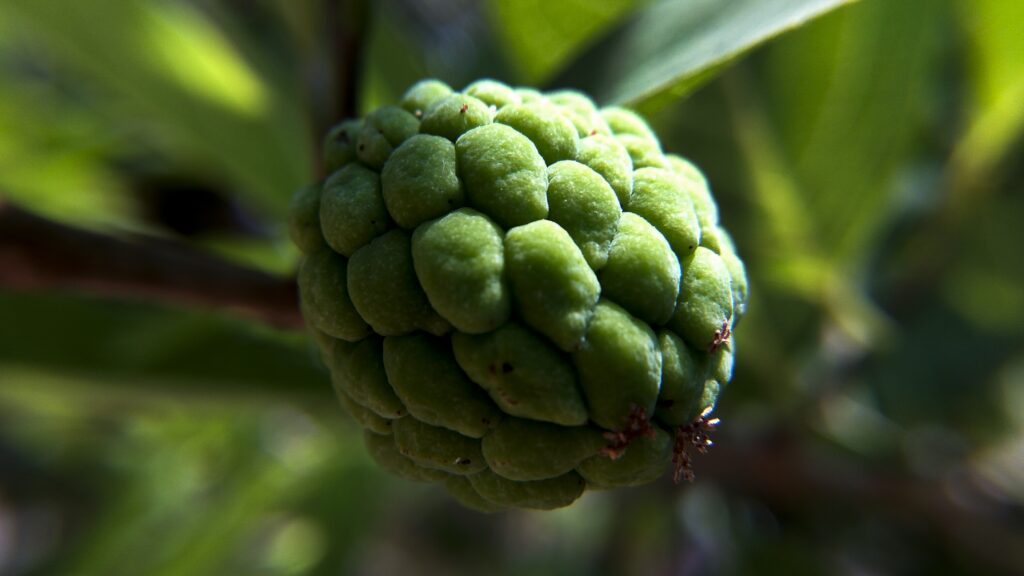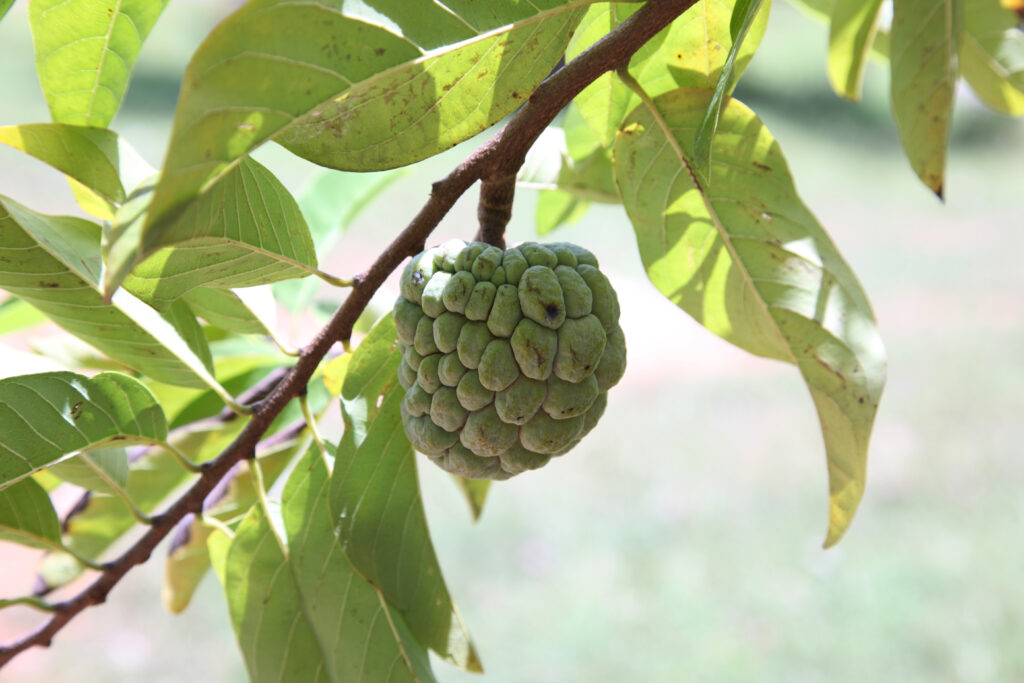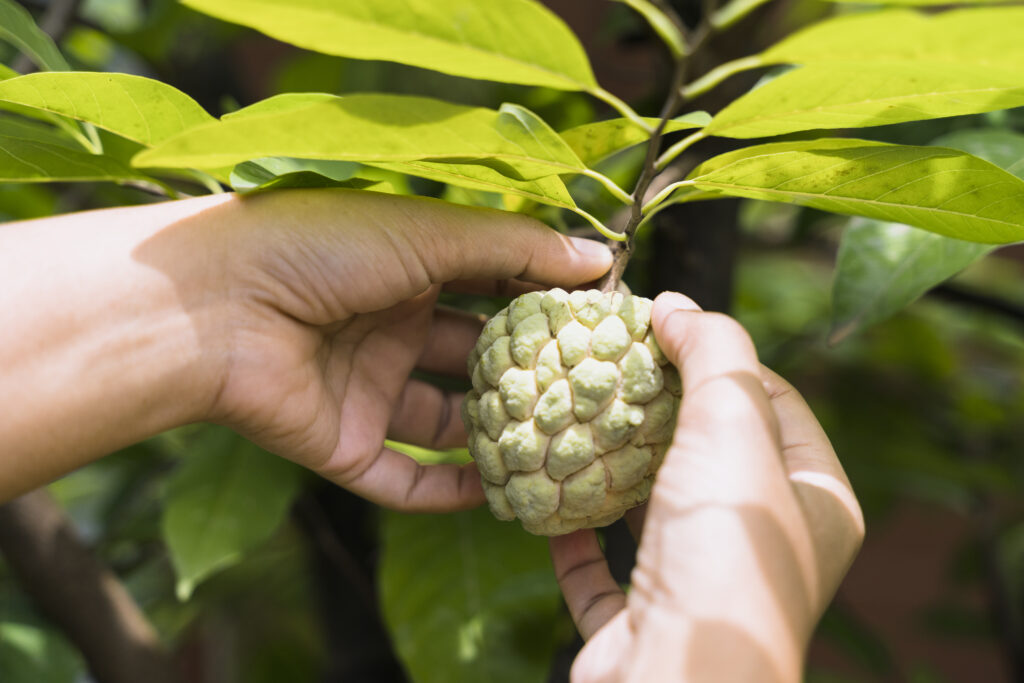Table of Contents
Have you ever bitten into a piece of fruit that tasted like a perfectly timed dessert? Picture the sweet flavor of banana, an exotic touch of pineapple, and silky custard, all folded in a one-of-a-kind scaly package. This is not made up; this is custard apple! A tropical gem that is as healthy as it is full of flavor. You may also know custard apple as sitaphal, sugar apple or cherimoya. The custard apple is steadily gaining popularity in the Western world, not only for its incredible taste but also custard apple benefits for health.
In this complete guide, we will discuss the custard apple’s nutritional content, health benefits, taste, how to grow it and side effects, if any. You will understand exactly why this exotic fruit deserves a spot on your menu.
These posts are very useful for nutrition gain in your diet journey- Star fruit benefits, Pineapple benefits, Avocado benefits…and more in health-icon.com

What is a Custard Apple?
Before exploring its advantages, it’s beneficial to familiarize ourselves with this distinctive fruit. The term “custard apple” is used mainly to refer to a number of species of trees and their fruit belonging to the Annona genus which are found in the tropical Americas. These are the cherimoya (Annona cherimola); the sweetsop or sugar apple (Annona squamosa); and the soursop (Annona muricata) among others. The name custard apple is appropriate, as its most noticeable characteristic is that it has soft, creamy flesh with a texture that resembles custard.
The trees, which will generally be small and evergreen, are unable to withstand frost and they prefer warm tropical to subtropical climates. They have strange flowers with curved six to eight fleshy petals, which develop into the composite fruits we know and love today. The flesh is often green and can be bumpy, scaly, or knobby on the outside, with sweet, creamy, succulent pulp on the inside with many dark uneatable seeds embedded in it.
Custard Apple Taste
Now we move on to the most thrilling aspect of your sensory experience, which is the flavor. When discussing the flavor of a custard apple, it feels like we’re describing a painting of a tropical oasis. The flavor profile is intricate and extremely sweet.
The flesh is creamy, soft, and tender with a melting texture, essentially accomplishing its “custard” designation. The flavor is often described as a rich combination of familiar fruits with sweet notes of banana and pear plus some tropical zing from the pineapple or strawberry, all with an undertone of smooth vanilla-like flavor. This natural sweetness with creamy texture makes it a great treat to eat fresh with a spoon directly from the skin.
Custard Apple Nutrition
Don’t let its dessert-like sweetness fool you; the custard apple is a nutritional powerhouse. Custard apple benefits are loaded with vitamins, minerals and other compounds to help you feel your best, and their nutritional profile is impressive:
• High in Vitamin C: One serving contains a large portion of your daily Vitamin C requirements, essential for immune function and skin health.
• High in Dietary Fiber: At roughly 5 grams of fiber per serving (greater than 17% of the daily recommended intake), custard apple is excellent for digestive health.
• A Good Source of B Vitamins: The custard apple benefits contains a good amount of B6, an important B vitamin for brain function, mood regulation and energy metabolism.
• Full of Minerals: A good amount of potassium and magnesium, both important for cardiovascular health and blood pressure management, can be found in the custard apple, along with some iron, calcium, and phosphorus.
• Contains Antioxidants: It is also high in antioxidants, such as lutein, important for eye health, and others that may help to reduce oxidative stress.
Custard Apple Calories
Custard apple, a fruit high in nutrients, is somewhat caloric because it contains natural sugar. The search results do not provide an exact number of calories of custard apple per 100g, but it is an energy-boosting fruit. As with any food, moderation is key in a balanced diet.

10 Remarkable Custard Apple Benefits
The rich nutrient content of the custard apple benefits leads to a wide range of specific health benefits. Here are ten great points for incorporating the fruit into your regular diet.
1. Boosts Immune System
The high Vitamin C content of the custard apple benefits will help strengthen your body’s immune defenses. Vitamin C can help stimulate the production of white blood cells and is an antioxidant that helps to protect cells from damage, and can even help to defend against common illnesses like the cold and flu.
2. Promotes Healthy Digestion
Due to the high fiber content of custard apple, it is great for healthy digestion. Fiber can add bulk to your stool to help promote regular bowel movements and prevent constipation. In addition, the soluble fiber in custard apple benefits can ferment in the gut to produce short-chain fatty acids (SCFAs) which help feed beneficial bacteria in the gut and may help prevent inflammatory bowel disease.
3. Supports Heart Health
The combination of potassium and magnesium in custard apple benefits makes it a heart-healthy choice. Potassium contributes to fluid balance and helps regulate sodium levels in the body, which is an important factor in managing blood pressure. Magnesium supports normal heart muscle functioning and promotes overall cardiovascular health.
4. Improves Eye Health
Custard apple benefits boast high levels of the carotenoid antioxidant lutein. Lutein is an antioxidant that combats free radicals that can ultimately harm the eyes. Higher consumption of lutein is correlated with a reduced risk of age-related macular degeneration (AMD) and cataracts, working to keep healthy eyesight as we age.
5. Boosts Energy and Regulates Mood
The Vitamin B6 in custard apple benefits plays an essential role in energy metabolism, contributing to the conversion of what you eat into energy and stave off that mid-afternoon crash. Vitamin B6 also contributes to the production of neurotransmitters including serotonin and dopamine, which regulates mood. Adequate levels of B6 are suggested to contribute to a lower risk of depression, making custard apple a “happy fruit”.
6. Provides Antioxidant Protection
Custard apple benefits provide additional antioxidant compounds in addition to lutein and vitamin C to help decrease oxidative stress in the body. By neutralizing dangerous free radicals, antioxidants can lower the risk of chronic diseases while providing overall long-term health benefits.
7. Improves Skin Health
The antioxidant properties, particularly its high vitamin C content, help to protect the skin against oxidative damage from outside sources, bringing about healthier and more radiant skin, and custard apple benefits help reduce the appearance of signs of ageing (e.g.-wrinkles and fine lines).
8. Provides Anti-Inflammation Benefits
Custard apple benefits help to soothe inflammation in the body due to the compounds that have anti-inflammatory benefits. These measures positively benefit overall inflammation, bring relief from pain, and provide general well-being when consumed regularly.
9. Assists in Blood Sugar Control (If Eaten Moderately)
Custard apple may be sweet, but it possesses a low glycemic index. This indicates that it releases sugar into the bloodstream at a slow rate. As a diabetic patient, it is acceptable for you to eat custard apple benefits moderately with the consideration that it will not lead to an immediate spike in blood sugar levels.
10. Strengthens Bones and Teeth
The fruit contains minerals important to bone and teeth health, including phosphorus and calcium. It is possible to meet recommended dietary allowances for these minerals by consuming custard apple benefits in your diet
Custard Apple Tree
If you are interested in how this fruit grows, the custard apple tree is fun to learn about. It is classified as a deciduous tree with heights from 15 to 35 ft with a trunk that may be curved or spreading. It is aesthetically unattractive, leaves that are hairy when young (pale green in color) but become smooth and lustrous as they mature.
For the gardener interested in tending it, it has moderate characteristics. The custard apple tree prefers a temperature range of 73 to 94 degrees Fahrenheit, high humidity, especially during flowering, and moist soil; however, for the gardener in dry areas, it is especially drought-tolerant, but may grow smaller and drop their leaves in severe drought conditions at which point, I will typically allow it to stay in its pot (if container grown) or just leave it the ground.
Both have survived being stressed for water. It is versatile in soil as well as drought resistance and will perform in saline soil, often grown on hills in barren lands.

Red Custard Apple
You may also see a beautiful variety called the Purple or Red Custard Apple (Annona reticulata). This variety is easily recognized by its beautiful skin which can be seen to be dark purple, ruby, red-purple, and possibly netted, and sometimes it can be violet or purple inside the flesh! That is a beautiful difference for the more commonly found white flesh.
Just like the skin, this custard apple variety has a flavor that we can describe as mildly sweet and tart, with some fruity notes of pear, raspberry, and strawberry combined with a hint of vanilla. The Purple Custard apple benefits can be enjoyed in the same ways as its green relatives. In some cultures, such as in India called Ramphal, serves a religious purpose as well.
Custard Apple Side Effects
Custard apples can certainly be enjoyed, but there are important precautions to ensure safe consumption.
• Toxicity of the Seeds and Skin: The seeds of the custard apple are toxic in nature and should never be consumed. Also, the skin itself should not be eaten. Always remove the seeds and skin before eating the pulp or flesh of the custard apple.
• Annonacin Content: Members of the Annona family, including cherimoya, have a toxin called annonacin in them. Highest concentrations of the toxin are in the seeds and skin of the fruit, which is the reason for their removal. Some studies show that consuming very high quantities of Annona fruit over a long period of time was linked to a risk of one form of Parkinson’s disease. Moderate consumption of the pulp has not been shown to increase risk.
• See a Doctor: As with any major dietary change, it’s always best to speak with a medical or nutritional professional before introducing new foods, especially if you have health issues.
How to Eat Custard Apples
Ready to try this fruit? Here’s how to enjoy it:
1. Choosing: Pick a fruit that feels heavy for its size and slightly yields to gentle pressure, like a ripe avocado might.
2. Preparing: Cut the fruit in half lengthwise. Use a spoon to scoop out the creamy pulp, being careful around the black seeds.
3. Eating: The easiest way to eat it is to spoon out the fresh pulp and eat it straight. You can also sprinkle a little sugar or even condensed milk on top for a gourmet touch.
4. In Recipes: Its creamy texture also makes it excellent for smoothies, milkshakes, ice creams, custards, and puddings. Adventurous cooks even use it in savory dishes or sauces.
Conclusion
The custard apple is undoubtedly more than a delicious tropical fruit. It’s a nutritional powerhouse, delivering a wide range of custard apple benefits – everything from boosting your immunity and digestion to safeguarding your heart, eyes, and mind.
Its strange dessert-like flavor makes it easy to enjoy healthy eating! You can take full advantage of this amazing gift of nature’s bounty after you learn how to choose, prepare it, and eat it safely (always discard the seeds and skin).
So the next time you see this funky, knobby fruit at your local market, don’t say “no way!” Bring it home, scoop out the luscious flesh, and enjoy the delicious benefits of health!
Note: This blog is educational information only. While you should consult a healthcare or nutrition professional to make any significant changes to your diet, eating custard apple will not harm you!
FAQs
How do you eat a custard apple and what does it taste like?
To eat a custard apple, cut it in half and scoop out the soft, creamy white pulp with a spoon, being sure to discard the seeds and skin. The taste is often described as a delightful mix of other fruits, with a sweet, creamy flavor reminiscent of banana, pineapple, and strawberry with vanilla-like undertones. You can enjoy it fresh, or add it to smoothies, fruit salads, yogurts, ice creams, and desserts.
Are there any side effects of eating custard apple?
Yes, there are some precautions. The seeds and skin are toxic and contain a compound called annonacin, which can be harmful to the nervous system if consumed in large quantities. Always discard the seeds and skin. Overconsumption of the pulp can lead to digestive issues like diarrhea or bloating due to its high fiber content, and may contribute to weight gain due to its calorie and sugar content.
Can people with diabetes eat custard apple?
Yes, in moderation. Custard apple has a low to moderate Glycemic Index (GI), ranging from 35 to 59, which means it does not cause rapid spikes in blood sugar levels. Its high fiber content helps slow down sugar absorption. However, due to its natural sugar content, portion control is essential, and it’s best to consult a healthcare provider for personalized advice.
What are the top health benefits of custard apple?
Custard apples offer numerous health benefits. They are rich in antioxidants which fight free radicals and may reduce the risk of chronic diseases. The high potassium and magnesium content supports heart health and helps regulate blood pressure. Their high dietary fiber promotes healthy digestion and gut bacteria. They also boost immunity through Vitamin C and support eye health with the antioxidant lutein .